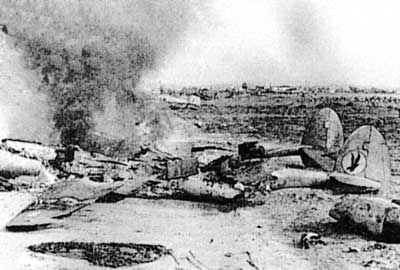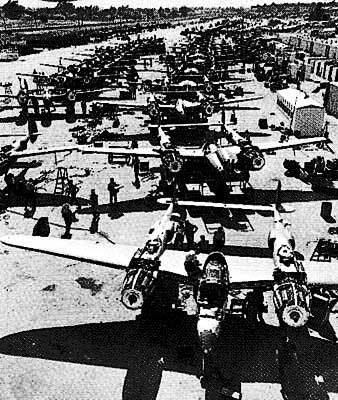

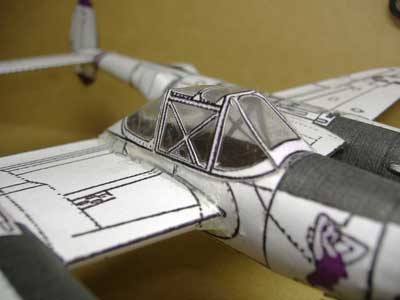
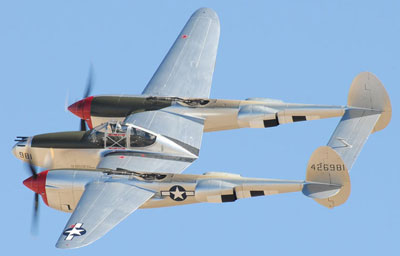
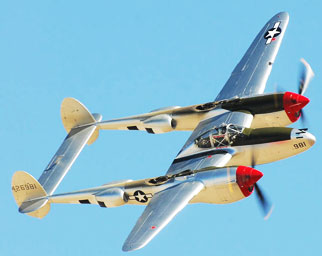
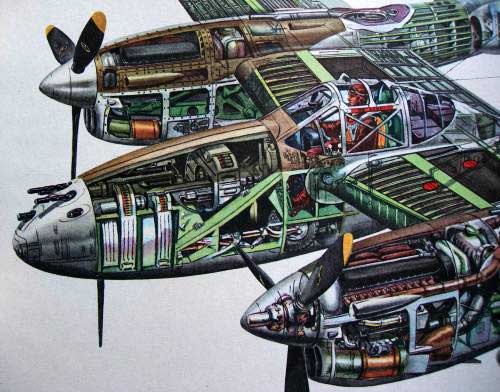
P-38 Lightning - $$5.50
The US heavy hitter in the WWII Pacific Theater. With drop tanks under its wings,the P-38 was used most successfully in the Pacific Theater of Operations and the China-Burma-India Theater of Operations where it enabled two airmen to achieve the highest-ever per pilot tally of American aerial victories.
Lockheed P-38 Lightning
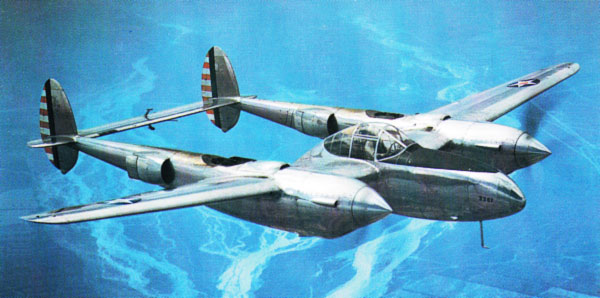
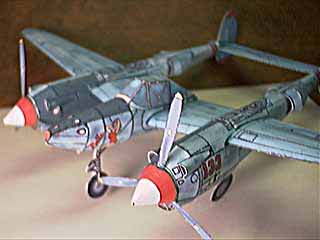
This twin boomed innovation was so powerful with it's twin supercharged engines that it could fly higher than the bombers it was designed to escort. One of it's early problems, however, was the lack of cockpit heating and at formation altitude it can be as cold as minus 50° F!
Another little problem was that we got a letter from a very lovely Marge Bong saying that her late husband Richard was mistakenly omitted from the text. She's right. We're sorry. And will fix it with the next printing. This card could possibly become a collector's piece. Hmmmmmm.
In fact, this card is the only model in the post card series that consists of TWO cards. We just couldn't get it all on one. It was printed in Metal-Glo and is just a little more complicated than usual.
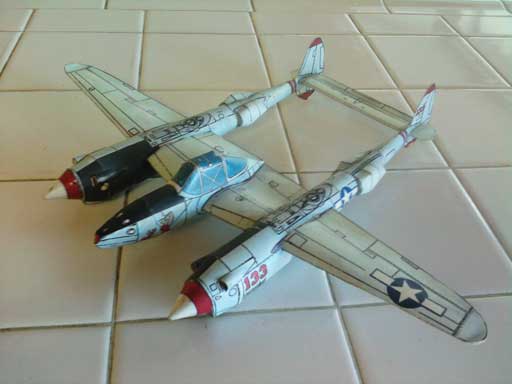 |
P-38 Lightning
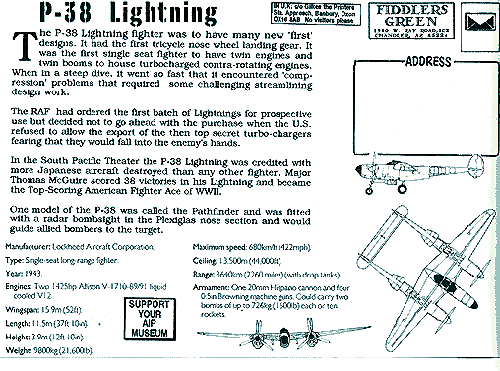 From the back of the FG P-38 Post Card model circa 1987 |
 |
|
 |
"Clear Cabin" Lockheed P-38 Lightning submitted by Bob Martin. Thanks Bob! |
Few would dispute the P-38's claim to epitomize the successful
realization of the long-range tactical fighter in World War 2.
Design work began early in 1937 to meet an exacting USAAC requirement.
Lockheed's Model 22 won the competition and in June 1937 one prototype,
designated XP-38, was ordered. It flew on 27 January 1939, followed
on 16 September 1940 by the first of 13 YP-38 evaluation aircraft
with more powerful V-1710 engines and nose armament of four machine-guns
and a 37mm cannon. 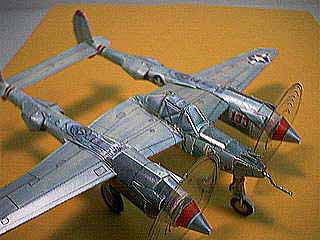
Delivery of production P-38s began in June 1941; 30 were built, one modified to an XP-38A with a pressurized cabin. The next production model was the P-38D (36 built), with self-sealing fuel tanks, and airframe modifications. The RAF ordered the type in 1940, naming it Lightning, but only three Mk Is with mn-supercharged engines were delivered; a contract for 624 Mk Us was cancelled. The remaining 140 Mk Is were repossessed as the P-322 by the USAAF, which also acquired the Mk Us; many were later convened to P-38Fs or Gs. Meanwhile, the USAAF's next version, the P-38E. entered production (210 built) with a 20mm replacing the 37mm cannon. Increased power was the major improvement in the F and G models, enabling the carriage of external weapons or fuel tanks for the first time.
Production of 527 P-38Fs and 1,082 P-3SGs, deliveries beginning during 1942, heralded a marked expansion in the P-38's deployment in the major theatres of the war. The P-38H of 1943 had further increased power; 601 P-38Hs were delivered. The 2,970 P-381s were similar, but introduced chin' air cooler intakes; increased internal fuel raised endurance (with drop-tanks) to 12 hours. Even greater numbers were built of the rocket-canyingP-38L, with l,600hr' V-1710-lll/113 engines and a maximum speed of 414mph . Lockheed manufactured 3,810 P-38Ls; 2,000 were ordered from Vultee, who completed 113 before the remainder were cancelled when the Pacific war ended. P-38s converted for other duties included a few P-38M night fighters from P-38Ls, a few TP-38L conversion framers, and the un designated 'Droop Snoot' and 'Pathfinder' (formerly] or L models). The most widely used single photo-reconnaissance aircraft of World War 2, nearly 1,400 E, F, G, H. I and
L models were converted to F-4s or F-5s.
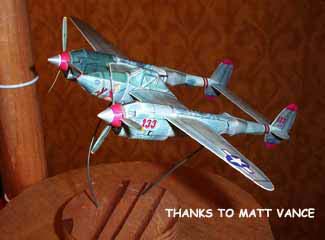 WHEN the United States Army Air Corps issued a specification
for a high-altitude interceptor in 1937, Lockheed were already
aware of the qualities demanded by the more forward looking theorists
such as Claire Chennault: speed, ceiling and firepower were the
prime requirements, and these, combined with the ability to carry
enough fuel for acceptable range, added up to a basic requirement
for power. Therefore, two of the new Allison v-1710 engines were
chosen, and after aiming every possible arrangement of two engines
the Lockheed designers settled on a twin boom configuration, with
pilot and armament in a central nacelle. Predicted performance
was such that this design was eventually selected by the Air Corps
and in June 1937 a prototype was ordered by the United States Army
Air Corps as the XP-38.
WHEN the United States Army Air Corps issued a specification
for a high-altitude interceptor in 1937, Lockheed were already
aware of the qualities demanded by the more forward looking theorists
such as Claire Chennault: speed, ceiling and firepower were the
prime requirements, and these, combined with the ability to carry
enough fuel for acceptable range, added up to a basic requirement
for power. Therefore, two of the new Allison v-1710 engines were
chosen, and after aiming every possible arrangement of two engines
the Lockheed designers settled on a twin boom configuration, with
pilot and armament in a central nacelle. Predicted performance
was such that this design was eventually selected by the Air Corps
and in June 1937 a prototype was ordered by the United States Army
Air Corps as the XP-38.
The XP-38 flew for the first time in January 1939, powered by two 960-hp V-1710s, but crashed on landing the following month after a record breaking transcontinental flight. The 13 YP-38s that followed in 1940-41 used one each of the V-1710-27 and -29 1150-hp engines with turbo superchargers, the different engine models being used to drive 'handed' propellers rotating in opposite directions. Armament was a 37-mm (1.46-in) M2 cannon plus four machine-guns, two each of 0.3-in (?.62-mm) and 0.5-in (l2.7-mm) caliber. By mid 1940 Lockheed had received orders from France, Britain and the USAAC. The French order was taken over by Britain as a result of the invasion of France, and since the British insisted that their Lightning I should have lower-powered, non supercharged engines and propellers rotating in the same direction, it proved unacceptable to the RAF.
All but three of the 140 Lightning Is were taken over by the USAAF and designated P-322s. The remaIning 524 Lightning ITs had 1325-hp V-1710-49/53 or V-17l0-51/55 turbo-supercharged engines and 'handed' propellers, but these too were taken over by the USAAF in 1942 and designated P-38F and P-38G.
Meanwhile, 30 production P-38s had been delivered to the USAAF
from mid 1941. These had 1150-hp V-1710-27/29 engines and all
four machine-guns were of 0.5-in caliber. However, the absence
of combat protection led to the introduction of the new designation
P-38D for the remaining 36 originally ordered, these having self-sealing
fuel tanks. The 210 P-38Es that followed replaced the 37-mm cannon
with a 20-mm (0.79-in) weapon.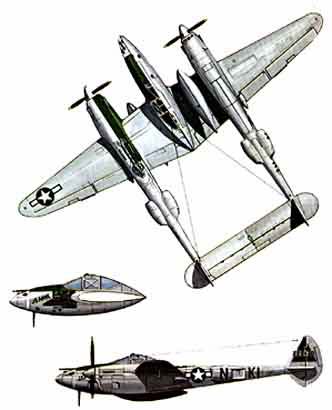
The Lightning remained in production until the end of the war, gaining steadily in performance and demonstrating remarkable versatility. The 527 P-38Fs produced from early 1942 introduced racks for two drop-tanks of up to 250 gal capacity or a pair of 1000-lb bombs, and later examples were the first to be fitted with Fowler flaps for improved combat maneuverability.
The last 200 of the 1082 P-380s built, and the 601 P-38Hs that followed, increased the bomb load to 32001b, the latter variant being powered by 1425-hp V-1710-89/91 engines. The same powerplant was used in the P-38J, but in conjunction with a new cooling system for the compressed air from the superchargers involving redesigned engine nacelles; this modification allowed the full power of the engine to be utilized and maximum speed to be raised to 414mph. A total of 2970 P-38Js were delivered from 1943, and production was completed by 3923 P-38Ls, with 1475-hp V-1710-111/113 engines.
Lightning's entered service in 1941 and were deployed in Europe, North Africa and the Pacific during 1942. Much of the type's early service was as a bomber escort, and later it was used extensively as a ground-attack aircraft carrying rockets or bombs. The Droop Snoot modification, with a navigator/bomb-aimer carried in the nose, and later radar-equipped Lightning's operated as pathfinders with P-38 formations on bombing missions. Towards the end of the war 75 P-38Ls in the Pacific were modified as P-38M radar-equipped night-fighters.
The Lightning ended the war with more Japanese aircraft to its credit than any other type, among its victims being the aircraft carrying the Japanese naval commander, Admiral Yamamoto who was flying in a Mitsubishi G4 MlL2 Navy Type I over Bougainville, in April 1943. Apart from many F-4 and F-S photo-reconnaissance conversions, individual P-38s were modified experimentally to act as glider tugs, torpedo carriers and smoke-layers.
Specifications for the Lockheed P-38 Lightning
|
Wingspan: 52 ft. Performance |
 |
 |
 |
|
| A: Early Lightning were notoriously uncomfortable, having a cramped cockpit that lacked proper heating. The first attempts at flying at high altitude resulted in pilots getting frostbite. | B: Unlike British twin-engine aircraft such as the Mosquito, the P-38 was built with engines turning in opposite directions. This eliminated engine torque reaction, making takeoff extremely simple. |
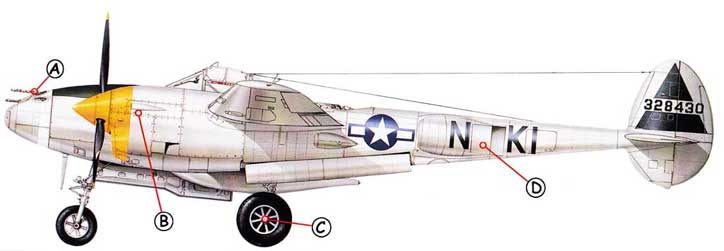 |
|||
| A: One 20-mm cannon and four heavy machine guns concentrated in the nose of the P-38 made it one of the hardest-hitting American fighters of the war. | B: The turbocharged Allison in-line engines were never the P-38's best feature, being prone to overheating. | C: The Lightning's tricycle undercarriage was a welcome new feature for pilots. It made engine maintenance easy for the engineers, as well as reducing accidents on takeoff and landing. | D: Turbocharged engines with boom-mounted radiators gave the P-38 superb high-altitude performance. |
BEGINNERS GUIDE - HOW TO BUILD FIDDLERS GREEN MODEL P-38 LIGHTNING
